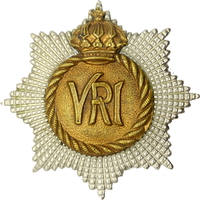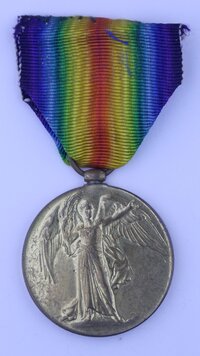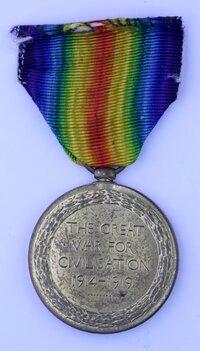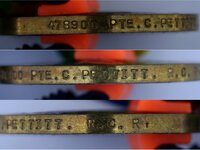
478900 Private Cornelius Pettitt
The Royal Canadian Regiment
By: Capt (ret'd) Michael M. O'Leary, CD, The RCR
Cornelius Pettitt was born in Hartest, Bury St. Edmunds, Suffolk, England, on 5 Nov 1874.
Pettitt enlisted in the British Army with the Suffolk Regiment on 30 Dec 1893, receiving the regimental number 3728. He served for 18 years 4 months in the Regular Army. A Chelsea Pension Board ledger details Pettitt's Foreign Service as: India (11 yr, 2 mo), Malta (2 yr, 4 mo), Egypt (2 mo), and Cyprus (1 yr). These overseas places of duty indicate that although he enlisted with and was discharged from the 1st Battalion of the Suffolk Regiment, he spent much of his service with the 2nd Battalion.
Discharged from Regular service on 3 May 1912 at the age of 36, Pettitt had received four Good Conduct Badges and his character on discharge was recorded as "Very Good." He was awarded a pension of 10 pence per day. His intended place of residence was 68 Cambridge Place, Cambridge, Suffolk.
Pettitt enlisted in the Canadian Permanent Force with The Royal Canadian Regiment at Halifax, N.S., on 13 Dec 1913. A 38-year-old "hall porter" (i.e., hotel porter), he was given the regimental number 9769.
The date of enlistment shown for Pettitt was not his first day at Wellington Barracks in Halifax. Instead, it is the day he boarded ship in England to emigrate to Canada with the intention of joining the army. Sailing from Liverpool, Eng., four soldiers aboard the Canadian Pacific liner R.M.S. Empress of Britain made the crossing to join The RCR (the others were 9766 Joseph Boulton, 9767 Alfred John Callow, and 9768 Sydney Matheson). Pettitt and the others landed at Halifax on 20 Dec 1913.
On 30 Jul 1914, five days before the declaration of war by the British Empire, The RCR was assembled at Halifax and deployed to to defensive locations in the Halifax Fortress complex and in No. 6 Canadian Divisional Military Area (i.e., Nova Scotia). The Regiment would maintain these duties for three weeks.
Pettitt, while on duty at Camperdown Signal Station overlooking the entrance to Halifax Harbour, wrote a letter to his brother and sister, a transcription of which survives in his C.E.F. service record:
"War Signal Station 10/8/14.
Camperdown.
"Dear Brother & Sister
"Just a line to let you know I am well and hope you and Annie are the same you must excuse me for not writing before but I have been expecting a letter from you. what do you think of the War and how long do you think it will last. I am expecting to go to Belgium with the Canadian Contingent but I am not quite sure yet I have put you my next to Kin so that if any thing should happen which I hope will not I want you to share with Lilly George and yourself which will be forward to you I thought it would be best to let you know as one can never tell I suppose you are getting plenty of excitement in Scotland we are getting plenty of it here we are at present stationed on the Coast of the Atlantic at the entrance of Halifax Harbour looking for German War War Ships but so far we have not had any fighting well old Man I must close.
"with best love to Annie and yourself I Remain your Loving Brother
"Joe
"Please address my letter to Pte C Pettitt, F. Coy, Wellington Bks, Halifax N.S., Canada
"and they will forward it on to me."
On 11 Sep 1914, The Royal Canadian Regiment sailed for Bermuda where they would serve for a year on garrison duty. On arriving in Bermuda, the Regiment relieved the 2nd Battalion, Lincolnshire Regiment, which sailed immediately for England. On 12 Aug 1915, The RCR was relieved in turn by the arrival of the 38th Overseas Battalion from Canada. The RCR returned to Halifax for a stay of only a week. During this time, the Regiment was re-attested for overseas service. Although The RCR had just spent a year in Bermuda, there were concerns regarding the applicability of the soldiers' Permanent Force enlistments for wartime deployments. This was, perhaps, prompted by the idea that a man on a P.F. three-year engagement could choose not to re-engage and the Government would be obligated to bring him home. Enlistment in the Canadian Expeditionary Force (C.E.F.), on the other hand, was for the "Duration of War." Accordingly, the soldiers of The RCR were re-attested, signing C.E.F. attestation papers in August 1915 before sailing for Europe.
When the RCR sailed for England, Pettitt remained at the regimental depot in Halifax. It would not be until early in 1916 that he would proceed overseas.
Pettitt attested for service in the C.E.F. at Halifax, N.S, on 15 Mar 1916. A 42-year-old soldier, Pettitt was described on his attestation paper as 5 feet 6 3/4-inches tall, weighing 168 1/2-pounds, with a 37-inch chest, a medium complexion, blue eyes, and brown hair. His religious denomination was Church of England. On his attestation form, Pettitt claimed prior service of 21 years with the Suffolk Regiment, likely indicating Reserve status after his discharge from the Regular Army. Pettitt identified his sister, Mrs. L. Long, 68 Cambridge Place, Hills Rd., Cambridge, as his next of kin. On attesting with The RCR for overseas service, Pettitt was given the C.E.F. service number 478900.
Crossing the Atlantic aboard the S.S. Olympic, Pettitt sailed from Halifax on 1 Apr 1916 and disembarked in England ten days later. On arriving overseas, he was taken on the strength of the 11th Reserve Infantry battalion, C.E.F.
The 11th Battalion, CEF, was authorized on 10 Aug 1914 and embarked for Great Britain on 30 Sep 1914. Redesignated the 11th Reserve Infantry Battalion on 29 Apr 1915, the unit provided reinforcements to the Canadian Corps in the field until 1917.
On 27 Apr 1916, Pettitt was struck off the strength of the 11th Res. Bn. to the R.C.R. & P.P.C.L.I. Depot. This depot at Caesar's Camp, East Sandling, was a short-lived unit that supported those two named regiments with drafts of reinforcements. It was created on 13 Feb 1916 by separating it from the 11th Reserve Battalion, and it was disbanded on 20 Jan 1917 when it was absorbed into the 7th and 26th Reserve Battalions.
Pettitt was drafted to France as a reinforcement for The RCR in the field on 6 Jun 1916. Notes in his record show that he reverts to the ranks at his own request in order to proceed overseas. He was apparently holding the rank of Acting Sergeant. Soldiers who had not previously seen service in the trenches were usually required to revert to the rank of Private to join a battalion at the front. Fighting units preferred to promote experienced soldiers within their ranks and capable men would regain rank and responsibility upon proving themselves as new vacancies allowed for advancement.
On 7 Jun 1916, Cornelius Pettitt was taken on the strength of The RCR in the field. About this time, he wrote a second letter for which a transcription can be found in his service record:
"My Darling Katie,
"Just a line to let you know I have arrived safely at my Destination hope you are well as it leaves me well not Darling I have an account at the Bank of Montreal if any thing happens to me I want you to write and get it this is the address:
"account No 4584 Pte C. Pettitt RCR Gottingen St North End Branch Halifax NS Canada
"I have about £100 s/0 d/0
"I must close now Dear, will write a longer letter next time.
"I Remain your Loving Joe. xxxx my love to Lilly xxx
"I hope you will be true until I come back Darling xx xxxx
"No 478900 Sgt. C. Pettitt A Coy., RCR, 1 Platoon 7 Bdg 3 Division, B.F. France."
Not having listed her as next of kin, or to be informed along with next of kin, Pettitt's service record leaves no further indication as to the identity of Katie.
Through the summer of 1916, the Regiment followed the cycle of rotations in forward trenches, support trenches, and reserve positions that would characterize the infantry experience of the Great War. Between early June and early October, 1916, the Regiment would cycle through the forward line of trenches five times, each rotation being about four days between relief operations. Like many soldiers of the war, Pettitt's experience was one of the steady cycle between trenches and reserve, until the Regiment went into action at Regina Trench.
It was on 8 Oct 1916 that Cornelius Pettitt would fall in battle. The names "Somme," "Ancre Heights," and "Regina Trench" are all applicable names for the action where he fell in battle. The Regiment's "Battle Bar Document" (prepared after the war by the Militia Department in anticipation of the possibility of clasps for the British War Medal) provides the following details for 8 Oct 1916:
"8 Oct 1916 —
"4.30 a.m. — Bn in "jumping off" position.
"4.50 a.m. — Bn advanced to the attack on REGINA TRENCH taking objective and many prisoners. The objective was held for four hours, during which time 3 counter-attacks were repulsed. Owing to Bn on Left having failed to reach their objective Bn was compelled to withdraw in order to avoid being outflanked."
The War Diary of The RCR relates a day of severe fighting on 8 Oct 1916 as the battle raged for Regina Trench. The narrative of the battle states only 140 effective members of the battalion marched from the battlefield, the remainder having been evacuated wounded, or buried. The following day's War Diary entry summarizes the cost:
"9-10-16. — TRENCHES. — "Cloudy, not quite so cool. See Appendix No. 4. Total casualties reported to date are Captain SAPTE, Lieuts. SIMPSON, WALSH, SUTTON and PENNIMAN, Missing 8-10-16. Major HODSON, Major WOOD, Lieuts. DICKSON, DWYER, BELL and MURRAY, WOUNDED 8-10-16. Killed 7 other ranks. Missing 207 other ranks. Wounded 68 other ranks. It is expected that most of those reported missing will be located through slips from Casualty Clearing Stations as having passed through dressing stations of other regiments on our flanks."
Cornelius Pettiit was killed in action on 8 Oct 1916. There are no surviving details of his death and his body was not recovered and identified. He has no known grave and is commemorated on the Vimy Memorial.
For his service in the C.E.F., Pettitt was entitled to receive the British War Medal and the Victory Medal. These were despatched to his brother Harry Pettitt, Esq., at "Oakhurst," 198 Wilmstow Rd., Fallowfield, Manchester, Eng., on 28 Feb 1921. Harry Pettitt would also receive the Memorial Plaque and Scroll Commemorating his brother's death. Since Pettitt was unmarried and his mother was predeceased, no silver Memorial Crosses were issued in his name. The plaque and scroll were despatched in 1922.
Pro Patria
Visit a randomly selected page in The O'Leary Collection (or reload for another choice):
- The O'Leary Collection; Medals of The Royal Canadian Regiment.
- Researching Canadian Soldiers of the First World War
- Researching The Royal Canadian Regiment
- The RCR in the First World War
- Badges of The RCR
- The Senior Subaltern
- The Minute Book (blog)
- Rogue Papers
- Tactical Primers
- The Regimental Library
- Battle Honours
- Perpetuation of the CEF
- A Miscellany
- Quotes
- The Frontenac Times
- Site Map
QUICK LINKS
The O'Leary Collection—Medals of The Royal Canadian Regiment
Newest additions:
![]()
![]() SB-12725 Private Henry "Hank" Ard
SB-12725 Private Henry "Hank" Ard ![]()
WIA at Hill 187, Died of Wounds in Japan
![]()
![]() 2355331 Lance Corporal Albert Lorking
2355331 Lance Corporal Albert Lorking
Wounded in action, later a War Amps representative.
![]()
![]() 4334 / 477996 Pte Isaac Hamilton Wilcox
4334 / 477996 Pte Isaac Hamilton Wilcox
Permanent Force, South Africa, and C.E.F.
![]()
![]() 477019 Private Harold Ashcroft
477019 Private Harold Ashcroft
Transferred to the Tunnelers.
![]()
![]() 734231 Private Clark D. Thompson
734231 Private Clark D. Thompson ![]()
The older Thompson brother, killed in action.
![]()
![]() 733849 Private Norman Parker Thompson
733849 Private Norman Parker Thompson
The younger Thompson brother; post-war service in the Special Guard.
![]()
![]()
![]() A305 / 400305 Private Andrew Walker
A305 / 400305 Private Andrew Walker ![]()
"Previously reported Wounded, now Killed in Action."
![]()
![]() 823298 Pte Thomas Patrick Steele, M.M.
823298 Pte Thomas Patrick Steele, M.M. ![]()
… for gallant conduct in the field …
![]()
![]() P13066 Sergeant Harold Thompson
P13066 Sergeant Harold Thompson
Instrumental Soloist for over 20 years of Canadian Army service.
![]()
![]() 9609 / 477728 Private Albert Edward Piper
9609 / 477728 Private Albert Edward Piper
"Arrived from England as a STOWAWAY …"





